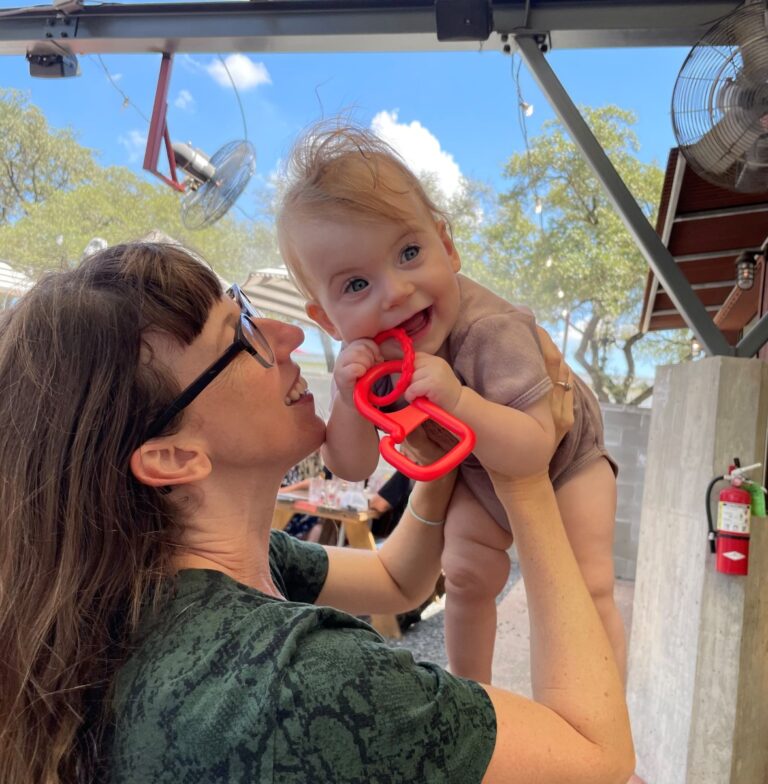I know the research says there are millions of neural connections forming per second in a newborn’s brain.
I know they sleep so much because they are learning so much and are exhausted from it.
Still. Until you get that eye contact, that smile, that squeal in response to something you said, it can be lonely and deeply unsatisfying to provide rich linguistic input for your newborn baby.
During the day I’m great at connecting, talking, and interacting with Bilingual Baby 2, and I know she hears me read books to her big sister.
But I’m not the mom that reads her poetry when we are up early mornings just the 2 of us, nor have I been singing to her when I put her down at night like I thought I would. I’m a person who loves silence.
So, that’s not an area where I’ve gone above and beyond.
But you should! Even though your newborn seems like a little blob, all the linguistic stimulation you surround them with is making a difference. And at 4 months babies have already started to recognize which mouth movements go with which sounds.
Bilingual Baby 2 is past the newborn stage now and has entered a wholly gratifying era. She smirks, she plays peak-a-boo, she follows us with her eyes and head, and she makes all kinds of sounds.
“Phoneme learning is a two-way street. Babies learn as much about speech sounds by practicing them as they do by hearing. And practice, for babies means babbling.” – Lise Eliot, PhD from her book What’s Going On in There? How the Brain and Mind Develop in the first Five Years of Life p 370
We want to attach meaning to everything our babies do, but a big reason for babble is getting practice coordinating and strengthening muscles in the lips, tongue, palate, and larynx.
I loved learning from What’s Going On in There? that around 5 months the first consonants that babies begin babbling are b, d, m, n, w, and j because they are formed using the same muscles they use for sucking bottles or nipples.
And a friend who is a bilingual speech therapist once told me that the open vowels that come first are the result of babies watching us open and close our mouths while we’re talking and eating. I believe it!
Below is a snippet of bilingual baby’s babble at 7 months old. There is a lot of raspberry-making, gurgling, spitting, and squealing. Not quite as much consonant-making (just da, da, da and ga, ga, ga) But you can hear her taking turns with me (the way you would in conversation). And she communicates a need in the middle; she’s tired of being on her belly, is annoyed, and starts whining to let me know she wants up.
Here’s a snippet of her baby babble at 8 months old. There’s a lot of pitch fluctuation where she goes from a really low vampire rumble up to a high squeal and back down. She reminds me of Laura, the director at Mi Casa Es Tu Casa where I work, warming her voice up before singing. Like Laura, baby is exercising her vocal chords, but she’s also discovering what her voice can do, and definitely watching for our reactions.
Here she is now, babbling away at 9 months. In this clip Bilingual Big Sister enters the conversation and it’s chaotic and hilarious and the feedback is so good for baby’s language development. You can really hear the difference from 7 months exploratory sounds to 9 month repetitive and confident da, da, da, da…
And one more of just me and baby having yogurt. I love the back and forth in our conversation. There’s so much repetition, and it’s so sing song-y. And even though she’s not speaking Spanish or English, she’s able to tell me that something tastes delicious, and towards the end she mirrors my tone as I’m telling her not to eat her chair. She sounds like a tiny kitten all blissed out on milk and play.
“…the sheer quantity of babbling is affected by the amount of attention adults pay to it. Parents who imitate and respond in other ways to their infants’ vocalizations will hear more of them, while those who ignore them end up inhibiting their children’s utterances, with potentially long-lasting ramifications.” From What’s Going On in There? pg 387
Bilingual Baby 2 has us trained to react and interact with her at every utterance.
I’m glad I got this post down, because nothing will be the same going forward. Babies first begin understanding that there’s a connection between meaning and sound around now. And apparently, after about 10 months babies begin babbling in ways that reflect their own language (or languages). Dr. Elliot says in her book that before then, babble in babies around the world sounds pretty similar. But, this New York Times article says that new born babies are already crying in the intonation of their mother tongue, so I bet if you know what to listen for, you could notice patterns in the babbling of babies from different countries.



